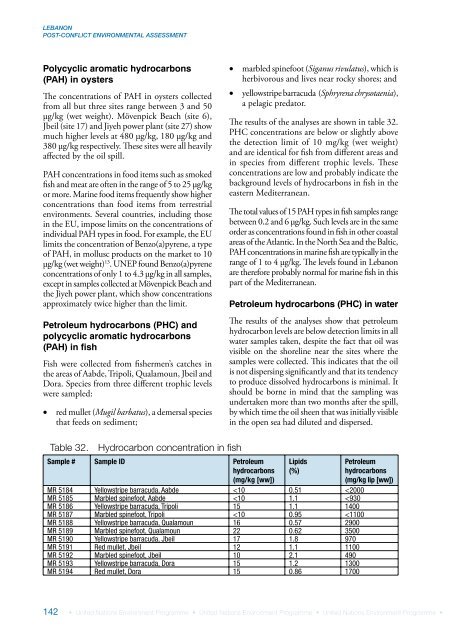Lebanon Post-Conflict Environmental Assessment - UNEP
Lebanon Post-Conflict Environmental Assessment - UNEP
Lebanon Post-Conflict Environmental Assessment - UNEP
Create successful ePaper yourself
Turn your PDF publications into a flip-book with our unique Google optimized e-Paper software.
LEBANONPOST-CONFLICT ENVIRONMENTAL ASSESSMENTPolycyclic aromatic hydrocarbons(PAH) in oystersThe concentrations of PAH in oysters collectedfrom all but three sites range between 3 and 50μg/kg (wet weight). Mövenpick Beach (site 6),Jbeil (site 17) and Jiyeh power plant (site 27) showmuch higher levels at 480 μg/kg, 180 μg/kg and380 μg/kg respectively. These sites were all heavilyaffected by the oil spill.PAH concentrations in food items such as smokedfish and meat are often in the range of 5 to 25 μg/kgor more. Marine food items frequently show higherconcentrations than food items from terrestrialenvironments. Several countries, including thosein the EU, impose limits on the concentrations ofindividual PAH types in food. For example, the EUlimits the concentration of Benzo(a)pyrene, a typeof PAH, in mollusc products on the market to 10μg/kg (wet weight) 13 . <strong>UNEP</strong> found Benzo(a)pyreneconcentrations of only 1 to 4.3 μg/kg in all samples,except in samples collected at Mövenpick Beach andthe Jiyeh power plant, which show concentrationsapproximately twice higher than the limit.Petroleum hydrocarbons (PHC) andpolycyclic aromatic hydrocarbons(PAH) in fishFish were collected from fishermen’s catches inthe areas of Aabde, Tripoli, Qualamoun, Jbeil andDora. Species from three different trophic levelswere sampled: red mullet (Mugil barbatus), a demersal speciesthat feeds on sediment; marbled spinefoot (Siganus rivulatus), which isherbivorous and lives near rocky shores; and yellowstripe barracuda (Sphryrena chrysotaenia),a pelagic predator.The results of the analyses are shown in table 32.PHC concentrations are below or slightly abovethe detection limit of 10 mg/kg (wet weight)and are identical for fish from different areas andin species from different trophic levels. Theseconcentrations are low and probably indicate thebackground levels of hydrocarbons in fish in theeastern Mediterranean.The total values of 15 PAH types in fish samples rangebetween 0.2 and 6 μg/kg. Such levels are in the sameorder as concentrations found in fish in other coastalareas of the Atlantic. In the North Sea and the Baltic,PAH concentrations in marine fish are typically in therange of 1 to 4 μg/kg. The levels found in <strong>Lebanon</strong>are therefore probably normal for marine fish in thispart of the Mediterranean.Petroleum hydrocarbons (PHC) in waterThe results of the analyses show that petroleumhydrocarbon levels are below detection limits in allwater samples taken, despite the fact that oil wasvisible on the shoreline near the sites where thesamples were collected. This indicates that the oilis not dispersing significantly and that its tendencyto produce dissolved hydrocarbons is minimal. Itshould be borne in mind that the sampling wasundertaken more than two months after the spill,by which time the oil sheen that was initially visiblein the open sea had diluted and dispersed.Table 32.Hydrocarbon concentration in fishSample # Sample ID Petroleumhydrocarbons(mg/kg [ww])Lipids(%)MR 5184 Yellowstripe barracuda, Aabde
















